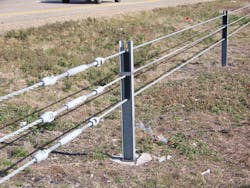University of Extrication: Cable Median Barriers – Part 1
Subject: Cable Median Barriers – Part 1
Topic: Cable Median Barrier Incident Considerations
Objective: Responders shall develop procedures for operations at center median incidents when a vehicle is contacting or entangled in tensioned cables
Task: The rescue team shall determine the presence of high-tension cable median barrier systems within their response district and develop procedures for incidents with vehicles in contact with the cable systems
As responders who respond to incidents on divided highways, we have dealt with collisions where one vehicle left its lane of the highway, crossed through the center median and collided violently with on-coming traffic with devastating results. In fact, in the few years prior to 2003, virtually all fatalities on interstate highways in the state of Texas (96%) were the result of cross-median crashes. To address this staggering statistic, the Texas Department of Transportation (DOT) actively began installing high-tension cable median barriers as a means of minimizing the effects of these cross-over collisions. Other states are following suit. North Carolina was the first to embrace guard cable installations on all of its interstate highways.
The original cable median barrier systems that became prevalent in the 1980s and ’90s are low-tension systems. The type of median barrier that is now becoming increasingly popular consists of three or four tensioned steel wire cables mounted on break-away steel posts. Cable post spacing for these barriers is typically 6½ to 15 feet apart. Once installed, the three-quarter-inch-thick, three-strand wire cables are tightened to a specific tension; typically 2,000 to 9,000 pounds of force. High-tension cable median barriers function by capturing, entangling, and redirecting the out-of-control vehicle as it slows to a halt but does not contact opposing traffic. Tensioned cables are more forgiving than traditional concrete barriers or the common steel W-shaped guardrails used today.
When responders arrive at an incident involving a vehicle that has crossed into the center median of an expressway and contacted a tensioned cable median barrier, the vehicle may be found touching, stretching or entangled in any or all of the three or four cables. Most likely, many of the steel posts near the crashed vehicle will be destroyed, broken or torn away during the collision by design.
If access to an occupant is obstructed by a cable stretched across the door or roof of a vehicle, the cables themselves may have to be dealt with. Even without patients obstructed, towing and recovery operations may be hindered when these cables are found snagged on a damaged vehicle.
Cutting the Cable
Responders may think that cutting the cable to gain better access is the easy and logical thing to do. It is easy, but it is very dangerous unless done correctly. Cutting a tensioned steel cable, although possible with a rotary saw or a hydraulic power cutter, should not be the rescue team’s “Plan A” tactic; it should be your last-resort tactic! When there are life-threatening injuries and the patients cannot be extricated without cutting the cables, there is a recommended procedure that is explained later in this column.
Instead of cutting the cables, crews should develop a flowchart of other tactics that can be used for tensioned cable entanglement. One of the first considerations in dealing with the cables should be to try to move the cables out of the way. Try lifting or lowering the cable out of the way of the door or roof area of the vehicle. A crew of personnel may be able to accomplish this manually.
If the cable won’t budge, a second tactic should be to consider removing support posts closest to the vehicle. If the posts are loose within their ground mounts, they can be lifted from their mounts or cut through near their base. This may create slack in the cables contacting the vehicle, again allowing the cables to be moved out of the way. If you start to raise the cables and the nearby support posts begin to lift also, be careful. It may be under significant tension if the cables are twisted around a vehicle. As you pull the post out of the way, it may be beneficial to secure the post with a chain or restraining device to prevent unwanted movement.
Because the steel cables are typically installed in continuous lengths of 1,000 feet, there will be metal turnbuckles somewhere on either side of your incident. A cable that is in the way may be able to be loosened at the turnbuckle on either side of the incident scene until enough slack is created that the cable can be moved sufficiently. This author recently worked at an incident where a jackknifed 18-wheeler was entangled in several of the tensioned cables. State DOT personnel who responded to the scene used large pipe wrenches to relax the turnbuckles enough to create slack in the cables, allowing the vehicle to be released.
High-tension cable barriers can withstand multiple vehicle strikes and still provide cross-over protection, but when the cables are cut, at least 1,000 feet of barrier is placed out of service until it can be replaced. Transportation departments charged with the responsibility of installing and maintaining these systems request that emergency responders avoid cutting the cable whenever possible. There is no clean way to splice the cables together once they are cut so an entire 1,000 feet of cable would have to be replaced. This is costly and ordering new cable sections could delay fixing the cable barrier in a timely manner.
When the cables are still obstructing your patient extrication pathway and these previous options have all been tried without success, cutting becomes the final choice. Before a tensioned cable is ever cut, there are a series of recommended protocols that need to be in place to make cutting a safe and effective operation. First, instead of cutting the cable itself, remember that 1,000-foot sections of cable are connected together, and tightened with metal turnbuckles. The first location to consider for cutting cable should be the center of a turnbuckle itself. This location keeps the cable itself intact and allows repairs to be done more quickly. Prior to cutting, releasing tension at the turnbuckle should be completed first.
Use extreme caution when cutting the cable or turnbuckle – especially when it is fully tensioned. If the cable has to be cut, the cut location for the saw or power cutter operator must be at a section of cable where the cables are parallel, not twisted or pulled out of alignment. It is critical that the cut location also be between two intact support posts to minimize cable movement as the cut occurs.
Once the cut location is determined, the incident safety officer can establish a hazard zone and clear it of all personnel. The rescuer cutting the cable will obviously be the only person near the cable. It is safest directly at the cut itself because the free ends will travel away from you, to your left and your right.
Cable-Cutting Demonstrations
In 2007, the Washington State DOT conducted a series of cable-cutting demonstrations. When a circular saw cut a tensioned cable between two undamaged posts, the cable on each side of the cut location retracted straight back about 15 feet toward the posts in each direction. Remember, it is like cutting a rubber band that is stretched tight. DOT officials reported that there was no whipping of the cable, but there was significant unraveling of the wire strands as the rotating saw blade made the cut. They recommend that the rescuer doing the cutting be protected with heavy gloves.
To address the frayed-end challenge, three to four wraps of duct tape were made on each side of the cable being cut in the second DOT demonstration. The holding power of the tape resulted in no frayed or unraveled strands at all. DOT officials recommend that responders wrap tape securely on both sides of the cable at the cut location prior to making the cut.
The third cable-cutting demonstration conducted by the Washington State DOT was very interesting. This time, a power rescue cutter was used instead of the rotary saw. To simulate the need to cut cable at a location where the posts had been torn away by the collision, all support posts were removed from the immediate area. To simulate a scenario where the cable is stretched around a vehicle at the scene, a construction machine was used to pull the cable about 15 to 20 feet from the center of the median. The demonstration showed that there was none of the anticipated whipping action of the cable as it was cut even though it was stretched and pulled out of alignment.
TASK: The rescue team shall determine the presence of high-tension cable median barrier systems within their response district and develop procedures for incidents with vehicles in contact with the cable systems.
• • •
In Part 2 of this series, a model standard operating guideline (SOG) featuring step-by-step protocols for dealing with cable median barrier incidents will be presented.
Ron Moore, a Firehouse® contributing editor, is training chief for the McKinney, TX, Fire Department. He also authors a monthly online article in the Firehouse.com “MembersZone” and serves as the Forum Moderator for the extrication section of the Firehouse.com website. Moore can be contacted directly at [email protected].
About the Author
Ron Moore
RON MOORE, who is a Firehouse contributing editor, recently retired as a division chief with the McKinney, TX, Fire Department and now serves with Prosper, TX, Fire Rescue. He self-published the Vehicle Rescue 1-2-3 training manual and serves as the forum moderator for the extrication section of Firehouse.com . Moore can be contacted directly at [email protected].

